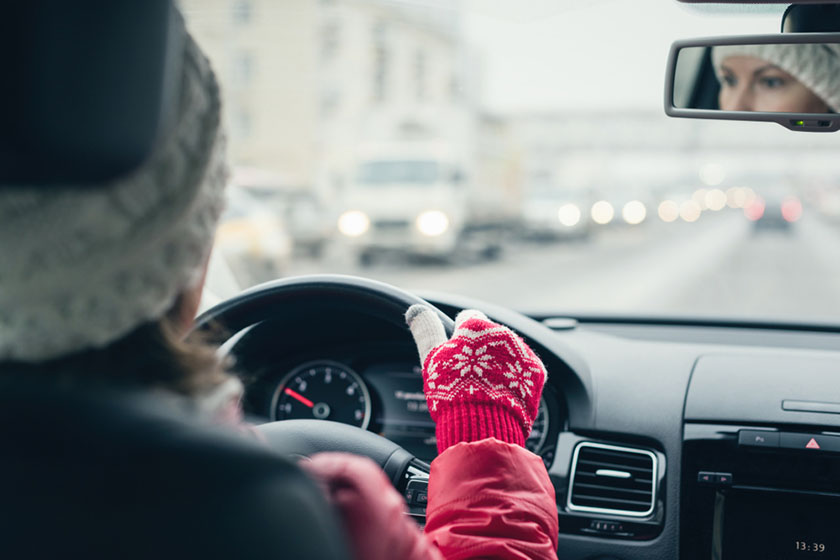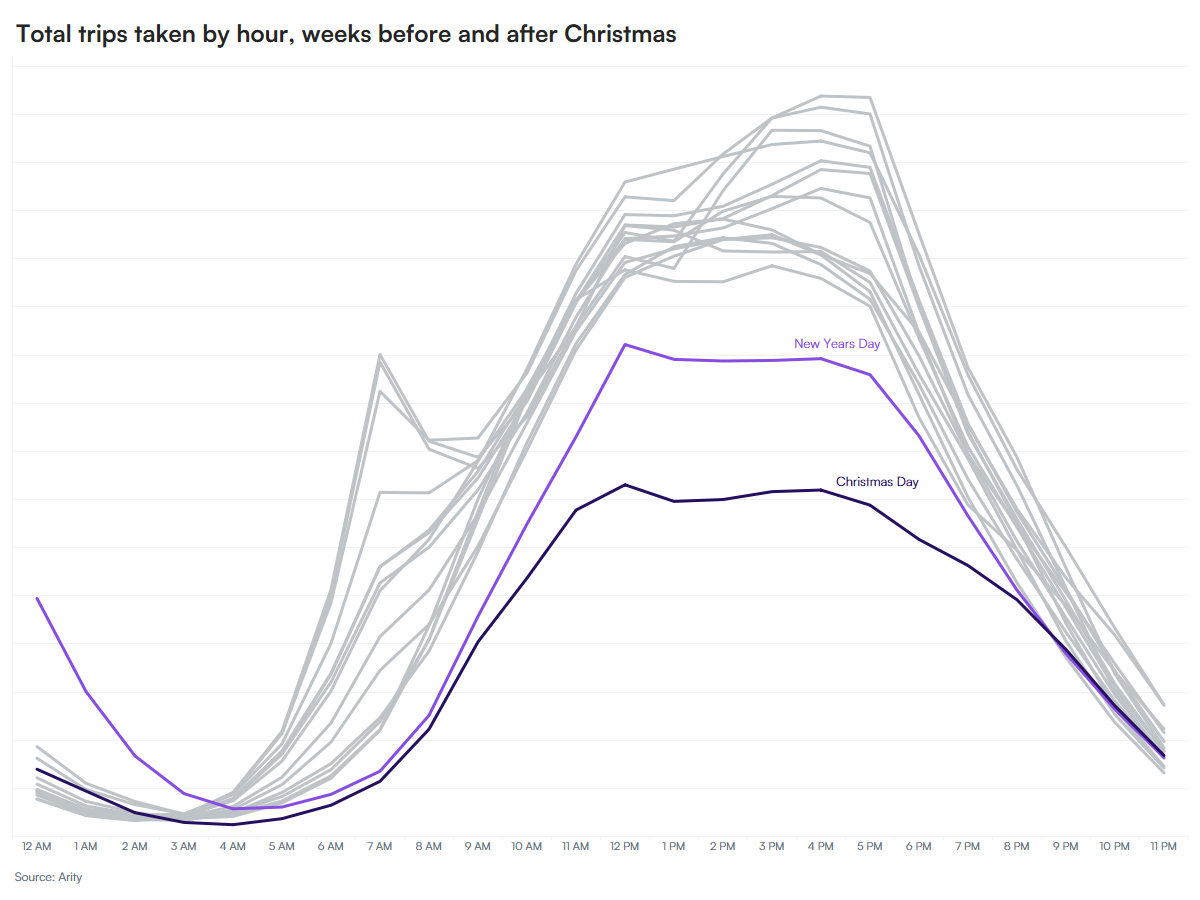Traffic takeaways: The Baltimore bridge collapse Read article


While the holidays are known as the happiest time of the year, it can also be one of the most stressful times with traveling being a top contributor to the “holiday blues.” Whether you’re driving to a different state, city, or zip code, it can be a hassle to pack up, load the car, onboard your family, and pick a hopefully safe, low-traffic route.
To help drivers travel smarter and safer, Arity’s data analytics team delved into our U.S. driving behavior dataset, which consists of nearly 40 million connections to U.S. drivers.
We looked at driving insights from 2020 – 2022 to uncover need-to-know trends for your Christmas and New Year’s travel plans. Here’s what we found:
When we look at our massive dataset, we see that the number of trips taken on Christmas Day drops dramatically relative to the days before and after. In the last three years, trips fell more than 30% on Christmas compared to the preceding and following days – likely as many people stay in and enjoy spending time with family.
Christmas hits on different days of the week each year, but even when it lands on a weekday, there’s much less morning traffic which more closely resembles traditional weekend travel.
In fact, when Christmas Day fell on a Friday in 2020, there were 83% fewer trips at 7 a.m. than at noon. This is similar to the 84% fewer trips at that time on Christmas Day in 2021 and 2022 which both landed on weekends – but varies greatly from other Fridays throughout the year, where some actually had more trips at 7 a.m than noon.

For Christmas, our data shows that driving at high speeds – specifically, driving over 80 mph – increases around the holiday, with the greatest rate of high-speed driving at 8 a.m. the day after Christmas.
In the last three years, drivers were 32%, 25%, and 68% more likely to travel at those higher speeds on the day after Christmas (the 26th) compared to the same day a week prior (the 19th).
Our dataset shows there is an increase in distracted driving the days leading up to Christmas compared to the days after. Over the last three years, distraction rates were on average 4% higher on Christmas Eve and Christmas Day compared to the three days prior and 8% higher compared to the three days after.
So, it’s especially important to put down hand-held devices and stay focused on the road.
As anticipated, given that many are heading out for midnight celebrations, drivers are hitting the road later in the night on New Year’s Eve with traffic volume heightened between midnight and 1 a.m., compared to “normal” nights. In fact, there are three times more people on the road during this period than the day before.
When looking across New Year’s Eve and New Year’s Day, we see the lowest level of high-speed driving (over 80 mph) during that same 11 p.m. to 1 a.m. timeframe. However, unfortunately, there is a high level of distracted driving on New Year’s Eve.
Distracted driving levels peak between 9 p.m. and midnight, 20% higher than the night before. And even though total distraction rates start to drop after that, January 1st sees 46% more distraction from midnight to 2 a.m. compared to the week prior.
With those distracted driving stats in mind, it’s unsurprising that levels of hard braking remain elevated throughout the night of New Year’s Eve. Compared to the day prior, drivers hit their brakes 20% more from 9 p.m. to midnight, with peak rates from 11 p.m. to midnight.
People seem to be staying in after their New Year’s Eve celebrations with 22% fewer trips on January 1st, compared to average daily trips for the week prior. In fact, it’s the third least driven day of the holiday season (November – January), following just Thanksgiving Day and Christmas Day.
As a mobility data and analytics company, it’s our mission to turn raw data into predictive insights that help make transportation smarter, safer, and more useful for everyone. Based on our recent analysis of the past three years’ travel trends, here are our recommendations for hitting the roads for the holidays:
You may want to plan ahead to avoid driving during high-traffic and high-risk time periods. If you’re traveling on Christmas Day, you may want to hit the roads early in the morning to avoid peak traffic around midday. For New Year’s Eve, it’s important to remember roads will stay busier through the late night with higher levels of distracted driving and hard braking.
With higher levels of travel around the holidays, there is increased risk for accidents. On top of that, our data suggests heightened levels of speeding the day after Christmas and, again, heightened levels of distracted driving and hard braking on New Year’s Eve.
For both holidays, we recommend being extra cautious while driving to and from your event. As always, try to minimize in-car distractions, maintain a safe distance with the vehicle in front of you, and remain aware of other drivers while you’re on the road.
Arity’s multi-source dataset with more than 40 million active connections includes anonymized and aggregated driving behavior data collected through consumer mobile apps, insurance telematics, and on-board device (OBD) programs.
Because the data is from multiple insurance and non-insurance sources and is not solely reflective of any Arity affiliate companies or any other particular industry or source, we really get a sense of how people are moving, where they are going, when, and how. Arity is connected to millions of U.S. drivers, so we have a credible representation in every state and demographic (e.g., families, single vehicles, rural, cities).
Keep in mind that although a majority of the trips Arity collects are personal trips, we have the capability to decipher between personal trips, gig driving, and non-driving impacts.
Because Arity collects various driving behaviors within a trip, we also can evaluate trends such as speeding, braking, acceleration, phone handling, and the time of day someone drives. For example, fueled by the largest telematics dataset tied to claims, we can more accurately predict dangerous driving behavior that we described in this report.